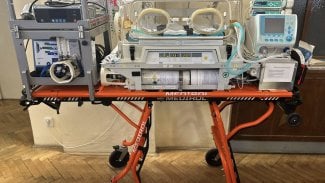__clone
NAME
clone, __clone2 - create a child process
SYNOPSIS
#include <sched.h> I int clone(int (* fn )(void *), void * child_stack , I int flags , void * arg , ... I /* pid_t * pid , struct user_desc * tls \ ", pid_t *" ctid " */ );"
DESCRIPTION
R clone ()
creates a new process, in a manner similar to
fork(2).
It is actually a library function layered on top of the underlying
R clone ()
system call, hereinafter referred to as
R sys_clone .
A description of
R sys_clone
is given towards the end of this page.
Unlike
fork(2),
these calls
allow the child process to share parts of its execution context with
the calling process, such as the memory space, the table of file
descriptors, and the table of signal handlers.
(Note that on this manual
page, "calling process" normally corresponds to "parent process".
But see the description of
CLONE_PARENT
below.)
The main use of
R clone ()
is to implement threads: multiple threads of control in a program that
run concurrently in a shared memory space.
When the child process is created with
R clone (),
it executes the function
application
R fn ( arg ).
(This differs from
fork(2),
where execution continues in the child from the point
of the
fork(2)
call.)
The
fn
argument is a pointer to a function that is called by the child
process at the beginning of its execution.
The
arg
argument is passed to the
fn
function.
When the
R fn ( arg )
function application returns, the child process terminates.
The integer returned by
fn
is the exit code for the child process.
The child process may also terminate explicitly by calling
exit(2)
or after receiving a fatal signal.
The
child_stack
argument specifies the location of the stack used by the child process.
Since the child and calling process may share memory,
it is not possible for the child process to execute in the
same stack as the calling process.
The calling process must therefore
set up memory space for the child stack and pass a pointer to this
space to
R clone ().
Stacks grow downwards on all processors that run Linux
(except the HP PA processors), so
child_stack
usually points to the topmost address of the memory space set up for
the child stack.
The low byte of
flags
contains the number of the
termination signal
sent to the parent when the child dies.
If this signal is specified as anything other than
R SIGCHLD ,
then the parent process must specify the
__WALL
or
__WCLONE
options when waiting for the child with
wait(2).
If no signal is specified, then the parent process is not signaled
when the child terminates.
flags
may also be bitwise-or'ed with zero or more of the following constants,
in order to specify what is shared between the calling process
and the child process:
R CLONE_PARENT (since Linux 2.3.12)
If
CLONE_PARENT
is set, then the parent of the new child (as returned by
getppid(2))
will be the same as that of the calling process.
If
CLONE_PARENT
is not set, then (as with
fork(2))
the child's parent is the calling process.
Note that it is the parent process, as returned by
getppid(2),
which is signaled when the child terminates, so that
if
CLONE_PARENT
is set, then the parent of the calling process, rather than the
calling process itself, will be signaled.
CLONE_FS
If
CLONE_FS
is set, the caller and the child processes share the same file system
information.
This includes the root of the file system, the current
working directory, and the umask.
Any call to
chroot(2),
chdir(2),
or
umask(2)
performed by the calling process or the child process also affects the
other process.
If
CLONE_FS
is not set, the child process works on a copy of the file system
information of the calling process at the time of the
R clone ()
call.
Calls to
chroot(2),
chdir(2),
umask(2)
performed later by one of the processes do not affect the other process.
CLONE_FILES
If
CLONE_FILES
is set, the calling process and the child processes share the same file
descriptor table.
Any file descriptor created by the calling process or by the child
process is also valid in the other process.
Similarly, if one of the processes closes a file descriptor,
or changes its associated flags (using the
fcntl(2)
F_SETFD
operation), the other process is also affected.
If
CLONE_FILES
is not set, the child process inherits a copy of all file descriptors
opened in the calling process at the time of
R clone ().
(The duplicated file descriptors in the child refer to the
same open file descriptions (see
open(2))
as the corresponding file descriptors in the calling process.)
Subsequent operations that open or close file descriptors,
or change file descriptor flags,
performed by either the calling
process or the child process do not affect the other process.
R CLONE_NEWNS (since Linux 2.4.19)
Start the child in a new namespace.
Every process lives in a namespace.
The
namespace
of a process is the data (the set of mounts) describing the file hierarchy
as seen by that process.
After a
fork(2)
or
clone(2)
where the
CLONE_NEWNS
flag is not set, the child lives in the same namespace as the parent.
The system calls
mount(2)
and
umount(2)
change the namespace of the calling process, and hence affect
all processes that live in the same namespace, but do not affect
processes in a different namespace.
After a
clone(2)
where the
CLONE_NEWNS
flag is set, the cloned child is started in a new namespace,
initialized with a copy of the namespace of the parent.
Only a privileged process (one having the CAP_SYS_ADMIN capability)
may specify the
CLONE_NEWNS
flag.
It is not permitted to specify both
CLONE_NEWNS
and
CLONE_FS
in the same
R clone ()
call.
CLONE_SIGHAND
If
CLONE_SIGHAND
is set, the calling process and the child processes share the same table of
signal handlers.
If the calling process or child process calls
sigaction(2)
to change the behavior associated with a signal, the behavior is
changed in the other process as well.
However, the calling process and child
processes still have distinct signal masks and sets of pending
signals.
So, one of them may block or unblock some signals using
sigprocmask(2)
without affecting the other process.
If
CLONE_SIGHAND
is not set, the child process inherits a copy of the signal handlers
of the calling process at the time
R clone ()
is called.
Calls to
sigaction(2)
performed later by one of the processes have no effect on the other
process.
Since Linux 2.6.0-test6,
flags
must also include
CLONE_VM
if
CLONE_SIGHAND
is specified
CLONE_PTRACE
If
CLONE_PTRACE
is specified, and the calling process is being traced,
then trace the child also (see
ptrace(2)).
R CLONE_UNTRACED (since Linux 2.5.46)
If
CLONE_UNTRACED
is specified, then a tracing process cannot force
CLONE_PTRACE
on this child process.
R CLONE_STOPPED (since Linux 2.6.0-test2)
If
CLONE_STOPPED
is set, then the child is initially stopped (as though it was sent a
SIGSTOP
signal), and must be resumed by sending it a
SIGCONT
signal.
CLONE_VFORK
If
CLONE_VFORK
is set, the execution of the calling process is suspended
until the child releases its virtual memory
resources via a call to
execve(2)
or
_exit(2)
(as with
vfork(2)).
If
CLONE_VFORK
is not set then both the calling process and the child are schedulable
after the call, and an application should not rely on execution occurring
in any particular order.
CLONE_VM
If
CLONE_VM
is set, the calling process and the child processes run in the same memory
space.
In particular, memory writes performed by the calling process
or by the child process are also visible in the other process.
Moreover, any memory mapping or unmapping performed with
mmap(2)
or
munmap(2)
by the child or calling process also affects the other process.
If
CLONE_VM
is not set, the child process runs in a separate copy of the memory
space of the calling process at the time of
R clone ().
Memory writes or file mappings/unmappings performed by one of the
processes do not affect the other, as with
fork(2).
R CLONE_PID (obsolete)
If
CLONE_PID
is set, the child process is created with the same process ID as
the calling process.
This is good for hacking the system, but otherwise
of not much use.
Since 2.3.21 this flag can be
specified only by the system boot process (PID 0).
It disappeared in Linux 2.5.16.
R CLONE_THREAD (since Linux 2.4.0-test8)
If
CLONE_THREAD
is set, the child is placed in the same thread group as the calling process.
To make the remainder of the discussion of
CLONE_THREAD
more readable, the term "thread" is used to refer to the
processes within a thread group.
Thread groups were a feature added in Linux 2.4 to support the
POSIX threads notion of a set of threads that share a single PID.
Internally, this shared PID is the so-called
thread group identifier (TGID) for the thread group.
Since Linux 2.4, calls to
getpid(2)
return the TGID of the caller.
The threads within a group can be distinguished by their (system-wide)
unique thread IDs (TID).
A new thread's TID is available as the function result
returned to the caller of
R clone (),
and a thread can obtain
its own TID using
gettid(2).
When a call is made to
R clone ()
without specifying
R CLONE_THREAD ,
then the resulting thread is placed in a new thread group
whose TGID is the same as the thread's TID.
This thread is the
leader
of the new thread group.
A new thread created with
CLONE_THREAD
has the same parent process as the caller of
R clone ()
(i.e., like
R CLONE_PARENT ),
so that calls to
getppid(2)
return the same value for all of the threads in a thread group.
When a
CLONE_THREAD
thread terminates, the thread that created it using
R clone ()
is not sent a
SIGCHLD
(or other termination) signal;
nor can the status of such a thread be obtained
using
wait(2).
(The thread is said to be
R detached .)
After all of the threads in a thread group terminate
the parent process of the thread group is sent a
SIGCHLD
(or other termination) signal.
If any of the threads in a thread group performs an
execve(2),
then all threads other than the thread group leader are terminated,
and the new program is executed in the thread group leader.
If one of the threads in a thread group creates a child using
fork(2),
then any thread in the group can
wait(2)
for that child.
Since Linux 2.5.35,
flags
must also include
CLONE_SIGHAND
if
CLONE_THREAD
is specified.
Signals may be sent to a thread group as a whole (i.e., a TGID) using
kill(2),
or to a specific thread (i.e., TID) using
tgkill(2).
Signal dispositions and actions are process-wide:
if an unhandled signal is delivered to a thread, then
it will affect (terminate, stop, continue, be ignored in)
all members of the thread group.
Each thread has its own signal mask, as set by
sigprocmask(2),
but signals can be pending either: for the whole process
(i.e., deliverable to any member of the thread group),
when sent with
kill(2);
or for an individual thread, when sent with
tgkill(2).
A call to
sigpending(2)
returns a signal set that is the union of the signals pending for the
whole process and the signals that are pending for the calling thread.
If
kill(2)
is used to send a signal to a thread group,
and the thread group has installed a handler for the signal, then
the handler will be invoked in exactly one, arbitrarily selected
member of the thread group that has not blocked the signal.
If multiple threads in a group are waiting to accept the same signal using
sigwaitinfo(2),
the kernel will arbitrarily select one of these threads
to receive a signal sent using
kill(2).
R CLONE_SYSVSEM (since Linux 2.5.10)
If
CLONE_SYSVSEM
is set, then the child and the calling process share
a single list of System V semaphore undo values (see
semop(2)).
If this flag is not set, then the child has a separate undo list,
which is initially empty.
R CLONE_SETTLS (since Linux 2.5.32)
The
newtls
parameter is the new TLS (Thread Local Storage) descriptor.
(See
set_thread_area(2).)
R CLONE_PARENT_SETTID (since Linux 2.5.49)
Store child thread ID at location
parent_tidptr
in parent and child memory.
(In Linux 2.5.32-2.5.48 there was a flag
R CLONE_SETTID
that did this.)
R CLONE_CHILD_SETTID (since Linux 2.5.49)
Store child thread ID at location
child_tidptr
in child memory.
R CLONE_CHILD_CLEARTID (since Linux 2.5.49)
Erase child thread ID at location
child_tidptr
in child memory when the child exits, and do a wakeup on the futex
at that address.
The address involved may be changed by the
set_tid_address(2)
system call.
This is used by threading libraries.
sys_clone
The sys_clone system call corresponds more closely to fork(2) in that execution in the child continues from the point of the call. Thus, sys_clone only requires the flags and child_stack arguments, which have the same meaning as for R clone (). (Note that the order of these arguments differs from R clone ().) Another difference for sys_clone is that the child_stack argument may be zero, in which case copy-on-write semantics ensure that the child gets separate copies of stack pages when either process modifies the stack. In this case, for correct operation, the CLONE_VM option should not be specified. Since Linux 2.5.49 the system call has five parameters. The two new parameters are parent_tidptr which points to the location (in parent and child memory) where the child thread ID will be written in case CLONE_PARENT_SETTID was specified, and child_tidptr which points to the location (in child memory) where the child thread ID will be written in case CLONE_CHILD_SETTID was specified.RETURN VALUE
On success, the thread ID of the child process is returned
in the caller's thread of execution.
On failure, a -1 will be returned
in the caller's context, no child process will be created, and
errno
will be set appropriately.
ERRORS
EAGAIN
Too many processes are already running.
EINVAL
CLONE_SIGHAND
was specified, but
CLONE_VM
was not.
(Since Linux 2.6.0-test6.)
EINVAL
CLONE_THREAD
was specified, but
CLONE_SIGHAND
was not. (Since Linux 2.5.35.)
EINVAL
Both
CLONE_FS
and
CLONE_NEWNS
were specified in
R flags .
EINVAL
Returned by
R clone ()
when a zero value is specified for
R child_stack .
ENOMEM
Cannot allocate sufficient memory to allocate a task structure for the
child, or to copy those parts of the caller's context that need to be
copied.
EPERM
CLONE_NEWNS
was specified by a non-root process (process without CAP_SYS_ADMIN).
EPERM
CLONE_PID
was specified by a process other than process 0.
VERSIONS
There is no entry for
R clone ()
in libc5.
glibc2 provides
R clone ()
as described in this manual page.
CONFORMING TO
The
R clone ()
and
sys_clone
calls are Linux specific and should not be used in programs
intended to be portable.
NOTES
In the kernel 2.4.x series,
CLONE_THREAD
generally does not make the parent of the new thread the same
as the parent of the calling process.
However, for kernel versions 2.4.7 to 2.4.18 the
CLONE_THREAD
flag implied the
CLONE_PARENT
flag (as in kernel 2.6).
For a while there was
CLONE_DETACHED
(introduced in 2.5.32):
parent wants no child-exit signal.
In 2.6.2 the need to give this
together with
CLONE_THREAD
disappeared.
This flag is still defined, but has no effect.
On x86,
R clone ()
should not be called through vsyscall, but directly through
R int $0x80 .
On IA-64, a different system call is used:
I int __clone2(int (* fn )(void *), I void * child_stack_base , size_t stack_size , I int flags , void * arg , ... I /* pid_t * pid , struct user_desc * tls \ ", pid_t *" ctid " */ );"
The
R __clone2 ()
system call operates in the same way as
R clone (),
except that
child_stack_base
points to the lowest address of the child's stack area,
and
stack_size
specifies the size of the stack pointed to by
R child_stack_base .
BUGS
Versions of the GNU C library that include the NPTL threading library
contain a wrapper function for
getpid(2)
that performs caching of PIDs.
In programs linked against such libraries, calls to
getpid(2)
may return the same value, even when the threads were not created using
CLONE_THREAD
(and thus are not in the same thread group).
To get the truth, it may be necessary to use code such as the following
#include <syscall.h>
pid_t mypid;
mypid = syscall(SYS_getpid);
SEE ALSO
fork(2),
futex(2),
getpid(2),
gettid(2),
set_thread_area(2),
set_tid_address(2),
tkill(2),
unshare(2),
wait(2),
capabilities(7),
pthreads(7)



















